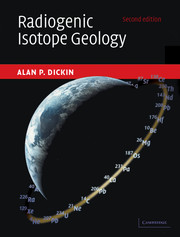Book contents
- Frontmatter
- Contents
- Preface
- Acknowledgements
- 1 Nucleosynthesis and nuclear decay
- 2 Mass spectrometry
- 3 The Rb–Sr method
- 4 The Sm–Nd method
- 5 Lead isotopes
- 6 Isotope geochemistry of oceanic volcanics
- 7 Isotope geochemistry of continental rocks
- 8 Osmium isotopes
- 9 Lu–Hf and other lithophile isotope systems
- 10 K–Ar and Ar–Ar dating
- 11 Rare-gas geochemistry
- 12 U-series dating
- 13 U-series geochemistry of igneous systems
- 14 Cosmogenic nuclides
- 15 Extinct radionuclides
- 16 Fission-track dating
- Index
16 - Fission-track dating
- Frontmatter
- Contents
- Preface
- Acknowledgements
- 1 Nucleosynthesis and nuclear decay
- 2 Mass spectrometry
- 3 The Rb–Sr method
- 4 The Sm–Nd method
- 5 Lead isotopes
- 6 Isotope geochemistry of oceanic volcanics
- 7 Isotope geochemistry of continental rocks
- 8 Osmium isotopes
- 9 Lu–Hf and other lithophile isotope systems
- 10 K–Ar and Ar–Ar dating
- 11 Rare-gas geochemistry
- 12 U-series dating
- 13 U-series geochemistry of igneous systems
- 14 Cosmogenic nuclides
- 15 Extinct radionuclides
- 16 Fission-track dating
- Index
Summary
‘Fission tracks’ are not, strictly speaking, radiogenic nuclides, but they are the damage tracks left by fission products, which represent a special kind of radiogenic nuclide. As such, the abundance of fission tracks in geological materials increases over time in the same way as the concentration of a radiogenic isotope. Fission-track dating was first developed simply as a dating tool for general application. However, the susceptibility of fission tracks to thermal re-setting, which was originally a disadvantage, has been put to very good use as a measure of cooling, uplift and burial processes.
Track formation
The spontaneous fission of 238U releases about 200MeV of energy, much of which is transferred to the two product nuclides as kinetic energy. They travel about 7 μm in opposite directions, leaving a single trail of damage through the medium which is about 15 μm long. Fission-fragment tracks were originally observed in cloud chambers and photographic emulsions. Subsequently, Silk and Barnes (1959) produced artificial tracks in muscovite by irradiating uraniumcoated flakes in a reactor. The resulting fragment tracks were observed at high magnification under the electron microscope.
‘Fission tracks’ (Fleischer et al., 1964) are found only in insulating materials. Fleischer et al. (1965a) proposed that the passage of the charged fission fragment causes ionisation of atoms along its path by stripping away electrons (Fig. 16.1a). The positively charged ions then repel each other, creating a cylindrical zone of disordered structure (Fig. 16.1b).
- Type
- Chapter
- Information
- Radiogenic Isotope Geology , pp. 451 - 471Publisher: Cambridge University PressPrint publication year: 2005



